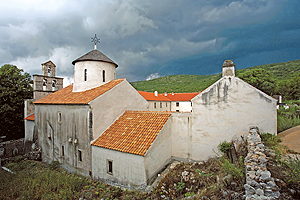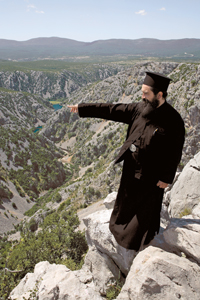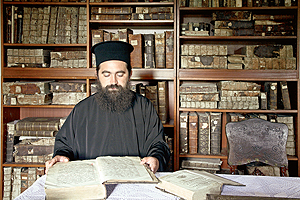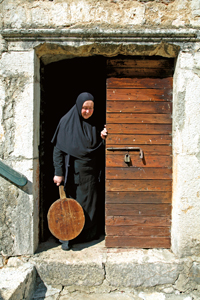Holy Place
SERBIAN MONASTERY OF KRUPA IN NORTHERN DALMATIA, FROM THE EARLY XIV CENTURY, AGAIN THE CENTER OF RENEWAL OF LIFE IN THE DESOLATED LAND
At the End of Indescribable Solitude
The people were exiled from there in the ultimate phase of a war led as fixed matches are played. What remained were empty villages and towns, toponyms and memories, sanctities without people. Then, eight years ago, the just arrived young prior of Krupa Gavrilo (Stevanović), while the wind was swinging the flame of the cresset through the ruined windows, began singing and held a service in the empty temple. Alone. Today it is not such any more, and sometimes more than six thousand people come to the Monastery saint day celebration, Assumption of Virgin Mary
By: Ljiljana Dugalić and NR Pres
Photographs: Dragan Bosnić
 He was standing on a height and watching. Nowhere a human to be seen, there was no smoke from the chimneys, no barking of a dog, no shepherd’s rattler, no road. As if everything was swallowed by macchia, avaricious and persistent. He was standing on a height and watching. Nowhere a human to be seen, there was no smoke from the chimneys, no barking of a dog, no shepherd’s rattler, no road. As if everything was swallowed by macchia, avaricious and persistent.
A desolated land.
And that there, looming over the river, are they really remains of some village, a site of fire washed by the coast hinterland rains, or is it just woven by his confused memory? When, in 1995, a decision was made to end that staged war, in which, for a while, everyone was participating in a way a fixed match is played, the people whom that land belongs to as far as the eye could reach and elsewhere across Krajina, were forced by crimes and brutalities to a mass exile. All of us will eternally remember those long rows of tractors, trucks, cars, carts, the river of betrayed and sold out desperate people, honorable and respectable homes tucked under a piece of plastic on the trailers. We will also remember the heroic aviation which bombarded those departing convoys of women and children on the roads of the neighboring country. Thirteen years have passed, yet we still remember the faces of the prosecutors, the faces of murderers, of destroyers, who rejoice as the winner of the crucial point in a fixed game rejoices. Can a ”historical victory” have the form of a grotesque, the form of a farce? No. If it is such, it is neither historical, nor a victory. However, someone else will put a point on that story, when the right time comes.
 The people have been exiled. What remained were empty villages and towns, toponyms and memories, Orthodox sanctities in an indescribable earthly solitude. ”They remained to meditate and wait for the times to change, for the people to return, for life, both spiritual and material, to be renewed.” The people have been exiled. What remained were empty villages and towns, toponyms and memories, Orthodox sanctities in an indescribable earthly solitude. ”They remained to meditate and wait for the times to change, for the people to return, for life, both spiritual and material, to be renewed.”
He slowly went down an overgrown narrow path towards the temple, holding the end of his cassock so it would not hook onto some thorny bush.
The Krupa monastery is the oldest Orhtodox monastery in the Diocese of Dalmatia, and most important besides Krka and Dragović. These three Northern Dalmatian pearls of Orthodoxy, located in the valleys of the rivers Krka, Krupa and Cetina, have been the spiritual and social centers of Orthodox Serbs of the Zadar and Šibenik hinterland for centuries.
Krupa was erected at the time of Serbian king Milutin. According to the legend, its foundations were placed by monks from a monastery in present Bosanska Krupa. In the foot of Velebit, a tall arch-like mountain separating the Mediterranean from the continent, the monastery church dedicated to the Assumption of Virgin Mary was painted by the famous Chilandar monk Georgije Mitrofanović, the same one who painted the famous Chilandar dining room.
In its seven centuries long history, Krupa was desecrated, destroyed and renewed several times. Besides Serbian kings Milutin and Stefan of Dečani, as well as Emperor Dušan, the restoration of this monastery in the XIX century was also supported by the Russian and Austro-Hungarian Empires.
Both the Serbian nation and the Orthodox monastery heavily suffered in the terrible XX century. The people were exiled and the sanctity remained amid the site of fire and ravaged land.
SERVICE IN AN EMPTY TEMPLE
 It was February 2000 when the 24-year old prior Gavrilo Stevanović, together with the Bishop of Dalmatia Fotije, entered Krupa. It was February 2000 when the 24-year old prior Gavrilo Stevanović, together with the Bishop of Dalmatia Fotije, entered Krupa.
Destroyed doors and windows, plundered rooms set on fire, bird nests in the devastated temple, sinister symbols of genocide and holocaust engraved with knives on the saints’ faces, dug out holy eyes, a testimony of brutality, viciousness and blasphemy.
Alone, without people of its faith nearby, the Monastery was an easy prey, where cowards could pretend to be heroes. Fortunately, the valuables and relics, icons and precious service objects were put in a safe place. A part of the valuable icons is in Belgrade, while a part was taken by experts from Zadar, who entrusted the sisters of the Catholic Benedictine order with them for safekeeping. The Benedictine sisters fulfilled their duty, and in 2002, the cleaned and preserved valuables from Krupa were returned to the Monastery.
– Without electricity and water, in the ghastly darkness which covered Lika for months, in that year of 2000, we began the renewal of the Monastery and life in it – says prior Gavrilo for National Review. – It seemed that all those sites of fire around us still had the scent of fire and misfortune. The first seven days were the hardest for me. Bears and wolves came down from the mountain, fanatical drunks came from who knows where into this ravaged land to threaten me, all sorts of beasts approached the Monastery. It was February!  Without electricity, in complete darkness and wilderness, surrounded by beasts! Everything was overgrown by the forest which seemed to burst in from every direction. There were no flocks to graze it, nor people to clear it. The road was hardly passable and two cars could not bypass. Wretchedness and misery. It took three years only to clean up the Monastery, to remove the junk and traces of savagery. Without electricity, in complete darkness and wilderness, surrounded by beasts! Everything was overgrown by the forest which seemed to burst in from every direction. There were no flocks to graze it, nor people to clear it. The road was hardly passable and two cars could not bypass. Wretchedness and misery. It took three years only to clean up the Monastery, to remove the junk and traces of savagery.
The surrounding villages were also desolated: only two houses remained in Golubić, five or six in Žegar. Old folks without furniture, without food, without flocks (in these lands called treasure). In the patched quarters of the Monastery, the Croatian police was with father Gavrilo all the time. Threats and insults were such that it was necessary.
In such a ghastly landscape, in an empty church, while the wind was swinging the flame of the cresset through the ruined windows, for the first time after five years, the young prior held the service. Afterwards, day after day, as he confides, he held the service more persistently and more dedicatedly, with greater enthusiasm and deeper faith, but still in an empty church. And while he held services and sang the liturgy songs, he says he could sometimes feel as if hovering. Somewhere from the depths, somewhere from the heights, strength came to him. Those first months, perhaps even more than a year, he held services in an area 200 kilometers in radius, in places scattered all over Lika, mostly in Lapac, Srb, Gračac, Medački džep...
EIGHT YEARS LATER
 After seeing the monks return, the people began regaining hope, slowly, with cautiousness resembling chronic fear. Hope that they can once again make their nests and find their homes in their land, although devastated, desolated, and empty. After seeing the monks return, the people began regaining hope, slowly, with cautiousness resembling chronic fear. Hope that they can once again make their nests and find their homes in their land, although devastated, desolated, and empty.
– Eight years after arriving to Krupa, we can say that both the Monastery and the museum are completely restored – says prior Gavrilo. – Also preserved was the valuable library, including books up to five centuries old. It used to be much richer, but a large part of it was destroyed in World War II and in earlier wars between the Turks and the Venetians. Many books were burned and lost without a trace.
Besides the prior, the old nun Paraskeva and a novice also live in the Monastery. Father Mihail used to live there too, but it was difficult for him to endure the emptiness of the land and absence of people, so he moved to a monastery in Montenegro. Young prior Gavrilo expects Krupa will soon completely renew its monastic life and be inhabited by nuns.
– The surrounding land belongs to the Monastery. We have excerpts from the land registers. The people will cultivate it. A water filling plant was erected at the spring of the Krupa, and people are working in it. We will also build a small hydroelectric power plant, first one in the country, and the Monastery will have its own electricity. Now about a thousand Serbs live in the surrounding villages. More than 200 houses were renewed in Žegar, 40 in Krupa, and more than 45 in Golubić. In the summer, on the Assumption day, more than six thousand people come to the Monastery celebration – says father Gavrilo.
More people are coming and more often. Foreigners also come.
– The Krupa flows through the valley, Velebit is in the distance, the river resembles Jordan, only it is greener and, it seems to me, more beautiful. You can drink water from it, it has trout, and the nature is divine. The air is clean, transparent, dry. The winter temperatures are never below minus five, and only for a few days. The summers are hot, but never too hot – continues father Gavrilo. – The people here are gradually becoming spiritually stronger. For half a century, this used to be an atheistic land, but young people today, with all the horrible experience they have, have a strong wish to participate in the ecclesiastical life. People from other parts also come to get married in the Monastery, to baptize their children.
There is still a lot to do. The icons should be finished, gates made, the monastic economy strengthened, but before all people should marry, baptize, pray and strengthen and increase the community. Krupa should be a spiritual foundation. The increased presence of the Serbs in the Monastery is bringing joy and hope that, after the great solitude and desolation, better days are expecting us.
In the name of that hope, father Gavrilo cultivates his garden with love, patiently strengthens his Monastery and waits.
***
Appointment
Father Gavrilo Stevanović was born in Tuzla and graduated theology in Sremski Karlovci. He calmly accepted the appointment given by the Bishop of Dalmatia Fotije and took over the position of prior of Krupa Monastery at the age of 24. He planted the garden himself. He grows tomato, cucumber, potato. There are also those who ”help themselves” to the juicy vegetables as if in a supermarket. Father Gavrilo is not angry with them, but invites them to stay and help with the numerous chores in the monastery.
***
Malfati
Lup and Ursula Malfati, an Orthodox couple, descendants of a noble Austrian family, found their piece in this medieval monastery. With their missionary work in Germany, they collected aid and helped repatriates to renew their homes here after the tragic year of 1995, to survive in the desolated land shattered with tragedies. The greatness of the love of this couple towards Krupa, these lands and people inhabited around the Monastery is such that, after his sudden death last spring, Lup was buried in Krupa.
***
Undertakings
With the blessing of His Eminence Bishop of Dalmatia Mr. Fotije, two significant monographs were published in Šibenik in 2007 and 2008 by ”Istina”, a publishing house of the Diocese of Dalmatia. The monograph of the Krka Monastery was published last year and this year of the Krupa Monastery. A detailed text about Krupa was written by Snježana Orlović, art historian, while the text about Krka was created by the editorial board of this sanctity’s fraternity. Both publications include photographs made by D. S. Tanasijević, M. Vujičić and our D. Bosnić.
Except for testifying about the ancientness of the two beautiful monasteries and their significance for the whole Serbian nation, these capital publications remind today’s generation of the testament left by their ancestors to persist in patience, to grow in faith and memory, to preserve tradition, culture and origins from oblivion. To show heroism in the most difficult times. In spite of everything!
***
Writers
Along with other valuables, Krupa also keeps a particle of the relics of St. Jerotej. Gerasim Zelić was an archimandrite here. He was a great traveler and significant Serbian writer, the first clergy member who became member of Matica Srpska (founded in 1826). Dositej Obradović spent some time in Krupa. The famous Serbian writer Simo Matavulj spent four years here and claimed that this is where he ”discovered the hidden beauties of the Serbian language”.
|
